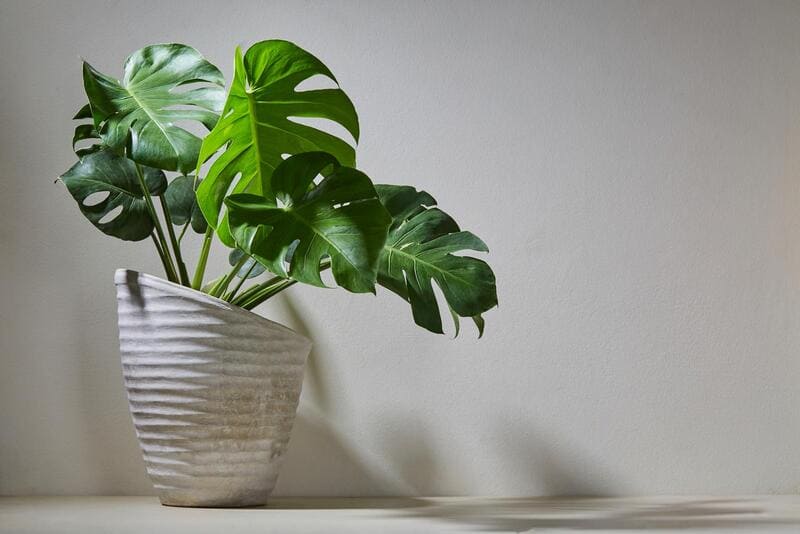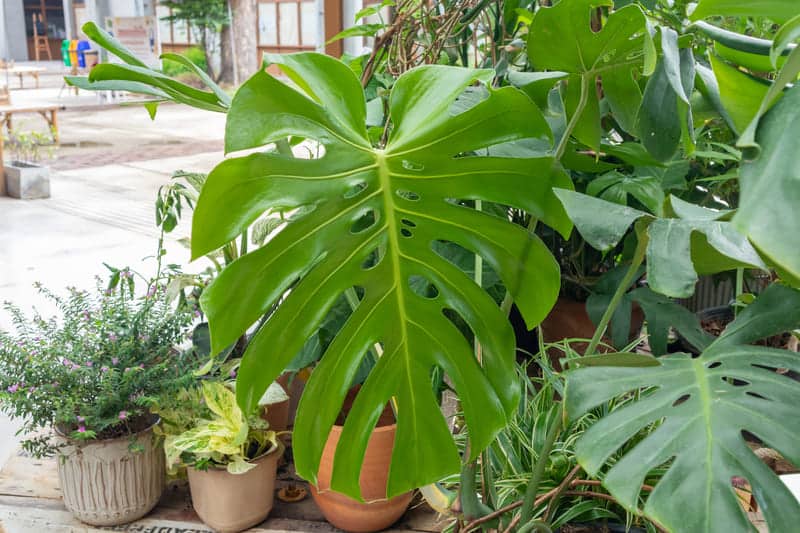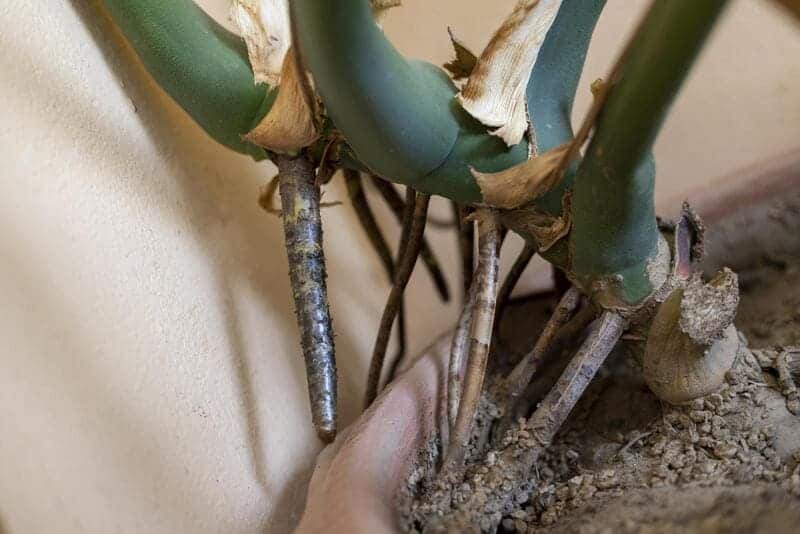Depending on the weather conditions of your region, Monstera plants can live outside if you provide proper conditions and care.
They’re easy to care for, so if you’re a plant enthusiast looking to elevate your green thumb skills or simply curious about the Monstera plant’s outdoor potential, you’ve come to the right place.
In this guide, we will explore everything you need to know about Monstera plant care to ensure it will grow and improve the appearance of your surroundings.
Can Monstera Live Outside?
Monstera plants can live outside if you provide proper conditions and care. These plants are native to the tropical rainforests of Central and South America, where they grow on the forest floor or as epiphytes on other plants.
Monstera plants require warm temperatures, humidity, and indirect sunlight to thrive. If all these conditions are met, Monstera plants will grow successfully in certain regions with similar climates, like tropical and subtropical areas.
Also check: Best Soil For Monstera Plant
However, remember that Monstera plants can be sensitive to cold temperatures, direct sunlight, and wind, and they require protection and care to avoid damage and stress.

How to Keep Monstera Healthy in Different Seasons?
If you want to keep Monstera plants healthy in different seasons, providing proper care and conditions for each season is important.
Here’s how to keep your Monstera plant healthy during each season:
Spring:
- In spring, your Monstera plant will grow faster as the weather gets warmer and days get longer. Therefore, you need to provide it with ample water and nutrients like a balanced fertilizer every 2-3 weeks
- If your Monstera plant has outgrown its container, spring is a good time to re-pot it. Choosing a slightly larger pot than the current one is important to avoid waterlogged soil and overwatering.
Summer:
- Monstera plants love warm weather and humidity, so ensure they have plenty of water and misting to maintain moisture levels.
- If you keep your Monstera plant outside, ensure it’s not exposed to direct sunlight and strong winds because they can cause stress or leaf burn.
Fall:
- In fall, when the weather gets colder and days get shorter, your Monstera plant will grow slower. Therefore, you need to decrease fertilization and reduce watering frequency.
- In the fall, you can check your Monstera plant for pests like spider mites or mealybugs and treat them to prevent them from damaging your plant.
Winter:
- If your Monstera plant is outside, you need to consider bringing it indoors or protecting it from freezing.
- Monstera plants can be sensitive to cold temperatures; therefore, you need to keep them in a warm and humid place. You can use a humidifier or pebble tray to increase humidity.
- In winter, you must fertilize your Monstera plant every 4-6 weeks and reduce the watering frequency.
If you follow these tips, your will maintain your Monstera plant healthy and beautiful throughout all the seasons.
Can Potted Monstera Go Outside?
Potted Monstera plants can go outside if you provide proper care and conditions for them. However, it’s important to gradually acclimate your Monstera plant to the outdoor environment to avoid any unwanted stress or shock.
Here’s a list of helpful tips on how to move your potted Monstera plant outside:
Choose the Right Location
Monstera plants best thrive in bright, indirect light, so you need to choose a shaded location that receives filtered light for part of the day. Don’t place the Monstera plants in direct sunlight because it can cause stress and leaf burn.
Provide Proper Drainage
The pot where your Monstera plant is potted must have drainage holes to prevent waterlogged soil. You can elevate the pot to avoid sitting water in case of heavy rain.
Protect From Wind
Place your Monstera plant in a sheltered location or use a windbreak because these plants can be sensitive to strong winds, which can damage their leaves or cause stress.
Monitor Temperature
Monstera plants prefer warm temperatures, so avoid exposing them to temperatures below 50°F-10°C.
Water and Fertilize Appropriately
Monstera plants must be watered regularly, so ensure you keep the soil moist but not soggy. During the growing season, fertilize your Monstera plant every 2-3 weeks with a balanced fertilizer.
With proper care, your potted Monstera plants can thrive outdoors and make your garden look like a tropical paradise.
More: Monstera Aerial Roots: What To Do With Them?
What Temperatures Can Monstera Tolerate?
As mentioned before, Monstera plants can be sensitive to cold temperatures and prefer warm temperatures.
In general, they can tolerate temperatures between 60-85°F(16-29°C) and may start to show signs of stress and suffer from cold damage if the temperature drops below 50°F-10°C. Temperatures above 95°F (35°C) can also be bad for Monstera plants.
So if the leaves of your Monstera plant start to turn yellow or brown, the plant is growing slower or even dying, which means it has suffered from cold damage.
To avoid this, keep your Monstera plant in a warm place, especially during winter.
If you keep your Monstera plant indoors, ensure it’s away from air conditioners, cold drafts, or heating vents to avoid temperature changes.
How Long Can Monstera Stay Outside?
The length of time that Monstera plants can stay outside depends on factors like temperature, climate, and weather conditions. Depending on the region, Monstera plants can generally stay outside from late spring to early fall.
If you provide your Monstera plants with proper conditions and care, they can thrive outside. It’s also important to protect your Monstera plants from extreme weather conditions like heavy rain, strong winds, frost, or direct sunlight.
If you live in a region with milder climates and warmer temperatures, you can keep your Monstera plants outside all year round with proper care and protected from cold temperatures.
In regions with colder climates or during winter months, keep your Monstera plants indoors to protect them from frost and freezing.
What is the Best Location for a Monstera Outside?
The best location for a Monstera plant outside is a spot that provides bright, indirect light where it’s protected from direct sunlight. Monstera plants prefer partially or fully shaded areas because direct sunlight can cause them stress and leaf burns.
Here’s how to find the best location for your Monstera plant outside:
Filtered Light
Monstera plants prefer bright, indirect light, so you need to choose a location that is shaded for part of the day or receives filtered light. Don’t place your Monstera plant in direct sunlight, especially in the afternoon.
Sheltered Location
Choose a location for your Monstera plant that is sheltered from heavy rain and strong winds because it’s sensitive to harsh weather conditions and strong winds.
Warm Temperatures
Monstera plants can suffer from cold damage if exposed to temperatures below 50°F (10°C). Therefore, choose a warm location protected from temperature fluctuations or cold drafts.
Humidity
Place your Monstera plants in a location with higher humidity levels, like near a water source where the moisture levels are high because these plants prefer humid environments.
Overall, the best location for a Monstera plant outside is a spot that provides filtered light, warm temperatures, and higher humidity levels to shelter from strong winds and harsh weather conditions.
Can Monstera Take Full Sun?
Monstera plants can take some full sun, but they can also be sensitive to it. They prefer bright, indirect light because direct sunlight can cause leaf burn, which appears as brown spots or patches on the leaves.
Therefore, it’s best to place your Monstera plant in place with partial shade or filtered light. Avoid keeping your Monstera plant in direct sunlight for long periods, especially during the hot afternoon hours, to prevent stressing the plant and leaf damage.
Suppose you want to place your Monstera plant in a sunnier place. In that case, you can acclimate it slowly by gradually increasing the amount of direct sunlight it receives over several weeks and providing some shade during the hottest part of the day. This way, you will allow the plant to adjust to the sun exposure and reduce the risk of damage.
In conclusion, Monstera plants can take full sun for 1-2 hours a day, but if you want to keep them healthy, thriving, and beautiful, it’s best to provide bright, indirect light.
Can I Put My Monstera on the Balcony?
You can put your Monstera plant on the balcony, but keep the following things in mind:
Choose a Spot That Provides Filtered Light or Partial Shade
Monstera plants prefer bright, indirect light and can be sensitive to direct sunlight. Choose a spot on the balcony that receives filtered light or is shaded for part of the day.
Protect Your Plant From Strong Winds
Balconies can be exposed to strong winds, which can damage your Monstera plant. Choose a location sheltered from strong winds or provide your plant with a windbreak, such as a screen or a trellis.
Protect Your Plant From Extreme Temperatures
Monstera plants prefer warm temperatures and can suffer from cold damage if exposed to temperatures below 50°F (10°C). Protect your plant from cold drafts or sudden temperature changes by placing it in a warm, protected spot on the balcony.
Water and Fertilize Your Plant Regularly
Balcony plants can dry out more quickly than plants in the ground. So, make sure to water your Monstera plant regularly and fertilize it during the growing season to promote healthy growth.
Placing your Monstera plant on the balcony can be a great way to add greenery and tropical vibes to your outdoor space. Just make sure to provide your plant with the proper care and protection to ensure that it thrives in its new environment.
Closing Thoughts
Monstera plants are a beautiful addition to any outdoor or indoor place where they can thrive if they receive proper care.
Monstera plants need adequate light, nutrients, and water to grow healthy and beautiful. If you want to take your Monstera plant outdoors, place it on a spot that provides filtered light, warm temperatures, and higher humidity levels sheltered from strong winds and harsh weather conditions.
With the tips above, you’ll be well-equipped to care for your Monstera plant, no matter where you choose to keep it. So, let your Monstera plant bask in the sun, and watch it thrive in all its natural beauty!



